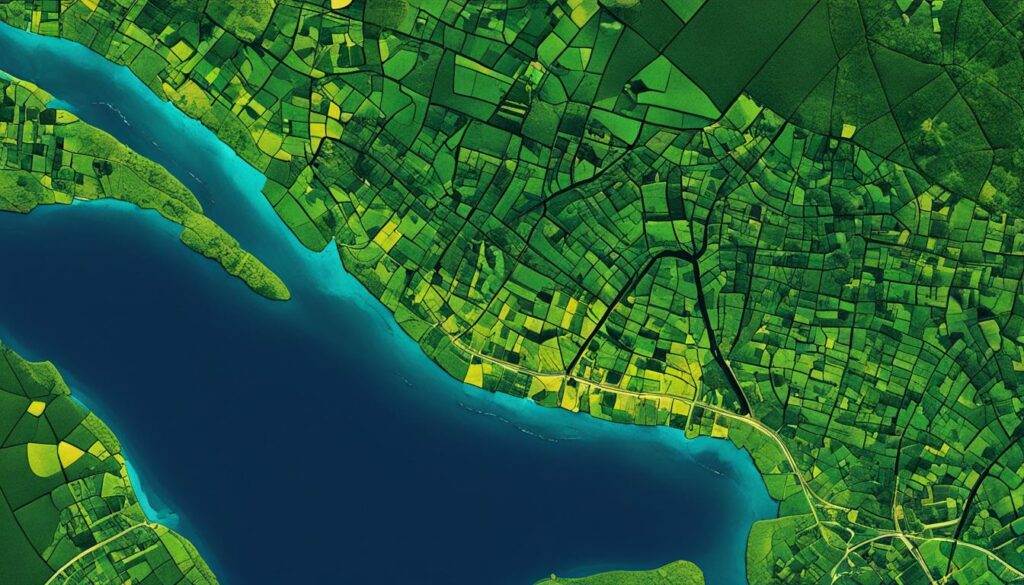Information technology (IT) has the power to address environmental challenges and promote sustainability. By implementing sustainable technology solutions and adopting eco-friendly practices, IT can help mitigate the environmental impact of information and communication technology. Green IT solutions and eco-friendly technology practices are essential for sustainable development, reducing carbon emissions, and improving resource efficiency. Through the use of green computing initiatives and other sustainable tech solutions, the IT sector can contribute to creating a greener planet.
Contents
- 1 Tackling Air Pollution and Wildfires with Digital Solutions
- 2 Advancing Freshwater Management with Digital Platforms
- 3 Combatting Climate Change with Data-Driven Solutions
- 4 Preserving Biodiversity through Digital Mapping
- 5 Building a Sustainable Future with Innovative Technologies
- 6 Conclusion
- 7 FAQ
- 7.1 How can information technology save the planet?
- 7.2 What is the environmental impact of information and communication technology?
- 7.3 How can IT contribute to environmental conservation and sustainable development?
- 7.4 How can technology help address air pollution and wildfires?
- 7.5 What digital platforms are available for freshwater management?
- 7.6 How is UNEP addressing climate change through data-driven solutions?
- 7.7 How does the United Nations Biodiversity Lab contribute to biodiversity preservation?
- 7.8 What are some innovative technologies for building a sustainable future?
- 7.9 What role does IT play in creating a greener planet?
- 8 Source Links
Key Takeaways:
- Information technology (IT) can play a significant role in addressing environmental challenges and promoting sustainability.
- Implementing sustainable technology solutions and adopting eco-friendly practices can help mitigate the environmental impact of information and communication technology.
- Green IT solutions and eco-friendly technology practices are crucial for sustainable development, reducing carbon emissions, and improving resource efficiency.
- Green computing initiatives and other sustainable tech solutions contribute to creating a greener planet.
Tackling Air Pollution and Wildfires with Digital Solutions
Air pollution and wildfires have become increasingly problematic issues worldwide, with devastating consequences for human health and the environment. To address these challenges, the United Nations Environment Programme (UNEP) is working on technology and innovation solutions to enhance environmental sustainability and combat air pollution. By harnessing data and digital technologies, such as data platforms, UNEP aims to accelerate global environmental action and promote major structural transformations. Digital tools like the Global Environment Monitoring System for Air (GEMS Air) allow real-time tracking of air quality and enable proactive measures to protect human health and reduce pollution risks.
“Digital solutions are revolutionizing the way we approach environmental hazards. By leveraging data and technology, we can effectively combat air pollution and wildfires, safeguarding the planet for future generations.” – UNEP
Addressing Air Pollution
Air pollution poses significant risks to human health and contributes to climate change. Through digital solutions, UNEP aims to monitor air quality, identify pollution sources, and implement targeted interventions. The Global Environment Monitoring System for Air (GEMS Air) provides real-time data on air pollution levels, enabling policymakers to make informed decisions and take proactive measures to improve air quality. By utilizing data platforms and digital tools, UNEP can drive global efforts to reduce air pollution and its adverse effects.
Combating Wildfires
Wildfires have devastating impacts on ecosystems, biodiversity, and human lives. Digital solutions play a crucial role in mitigating and preventing wildfires, enabling early detection, rapid response, and effective management. Through satellite imagery and remote sensing technologies, UNEP can monitor fire-prone areas and predict fire behavior. The integration of data platforms, such as the Fire Information for Resource Management System (FIRMS), allows stakeholders to access real-time fire information and coordinate firefighting efforts. By leveraging digital solutions, UNEP aims to reduce the occurrence and severity of wildfires, protecting both the environment and human communities.
| Benefits of Digital Solutions for Air Pollution and Wildfires | Examples |
|---|---|
| Real-time monitoring of air quality | Global Environment Monitoring System for Air (GEMS Air) |
| Early detection and prediction of wildfires | Fire Information for Resource Management System (FIRMS) |
| Coordination of firefighting efforts | Integration of data platforms |
| Improved understanding of pollution sources | Data analytics and modeling |
Advancing Freshwater Management with Digital Platforms
The management of freshwater resources is crucial for sustainable development and environmental conservation. To address this pressing need, the United Nations Environment Programme (UNEP) has developed innovative digital platforms for monitoring water resources and promoting effective freshwater management.

One such platform is the Freshwater Ecosystem Explorer, which provides detailed information about the state of lakes and rivers worldwide. This digital tool leverages earth observation, cloud computing, and artificial intelligence to collect and analyze data on freshwater resources. By offering policymakers and citizens valuable insights into the status of these ecosystems, the Freshwater Ecosystem Explorer facilitates informed decision-making and supports sustainable water management.
Through the use of advanced technologies, this platform tracks progress towards Sustainable Development Goal Target 6.6, which aims to ensure the availability and sustainable management of water and sanitation for all. By monitoring key indicators and providing real-time data, the Freshwater Ecosystem Explorer contributes to achieving this important goal and fostering a more water-secure future.
Benefits of Digital Platforms for Freshwater Management
The adoption of digital platforms for freshwater management brings several benefits:
- Improved data availability: Digital platforms enable the collection and sharing of comprehensive data on freshwater resources, facilitating evidence-based decision-making.
- Enhanced monitoring capabilities: Through remote sensing technologies and data analytics, digital platforms provide real-time and accurate information about the quality and quantity of water resources.
- Effective resource allocation: With access to precise data on freshwater availability, policymakers can allocate resources efficiently, ensuring equitable access to water and sanitation services.
- Support for policy development: Digital platforms offer valuable insights that inform the development of policies and regulations for sustainable freshwater management.
Case Study: The Freshwater Ecosystem Explorer in Action
“The Freshwater Ecosystem Explorer has revolutionized our approach to freshwater management. Its comprehensive data and user-friendly interface have empowered us to make informed decisions and take proactive measures to protect our precious water resources.” – Ministry of Environment, Country X
| Key Features of the Freshwater Ecosystem Explorer | Benefits |
|---|---|
| Detailed global freshwater data | Provides a comprehensive understanding of the state of lakes and rivers worldwide |
| Real-time monitoring | Enables timely interventions to address water quality and quantity issues |
| Interactive maps and visualizations | Facilitates easy interpretation and communication of complex data for stakeholders |
| Data-driven decision-making | Supports evidence-based policy development and resource allocation |
Combatting Climate Change with Data-Driven Solutions
Climate change is a pressing global issue that requires urgent action. One major contributor to climate change is methane emissions, a potent greenhouse gas. To effectively combat this problem, the United Nations Environment Programme (UNEP) is leveraging data-driven solutions and partnerships to drive deep reductions in methane emissions.

The International Methane Emissions Observatory (IMEO), established by UNEP, plays a crucial role in collecting data from various sources to identify the origins of methane emissions. By understanding the sources, necessary actions can be taken to reduce these emissions. Through collaboration with the oil and gas industry and the scientific community, UNEP aims to improve methane emissions reporting and fund studies that provide robust data for effective climate change mitigation measures.
The Global Methane Assessment, published by UNEP, highlights the potential impact of methane reduction on global warming and human health. This comprehensive report emphasizes the need for immediate action to address methane emissions and highlights the available strategies for doing so.
Reducing methane emissions not only helps combat climate change but also has significant co-benefits for human health, as methane contributes to air pollution and the formation of smog. It is crucial that we prioritize efforts to address this issue and implement effective measures to reduce methane emissions.
By harnessing the power of data and scientific collaboration, UNEP is driving the development of strategies and initiatives to minimize the impact of methane emissions on the environment and human well-being. Through the implementation of data-driven solutions, we can make significant progress in combatting climate change and creating a more sustainable future.
Preserving Biodiversity through Digital Mapping
Biodiversity preservation is crucial for maintaining the balance of ecosystems and safeguarding the Earth’s natural resources. To support this endeavor, the United Nations Environment Programme (UNEP) advocates for the use of the United Nations Biodiversity Lab—a powerful digital platform that showcases data and maps illustrating the extent of nature and the impact of human development. By visualizing spatial data, decision-makers gain a deeper understanding of the necessity to preserve natural systems in order to protect biodiversity.
The United Nations Biodiversity Lab has been widely accessed by numerous countries for national reporting to the Convention on Biological Diversity. This integration helps countries effectively monitor and evaluate their progress in safeguarding biological diversity. As part of UNEP’s comprehensive World Environment Situation Room, which combines various digital platforms, the United Nations Biodiversity Lab contributes to a connected ecosystem of data and analytics for monitoring environmental progress at multiple levels.
| Benefits of the United Nations Biodiversity Lab: |
|---|
| Allows decision-makers to visualize spatial data |
| Highlights the impact of human development on biodiversity |
| Aids in national reporting to the Convention on Biological Diversity |
| Contributes to a comprehensive ecosystem of data and analytics in the World Environment Situation Room |
“The United Nations Biodiversity Lab provides an invaluable tool for decision-makers to understand the intricate relationship between human development and the preservation of biodiversity. By visualizing spatial data, we can collectively work towards the conservation of natural systems.”
By utilizing digital mapping and data-driven solutions like the United Nations Biodiversity Lab, we can take significant steps towards preserving biodiversity. This, in turn, ensures the continued existence of diverse species, maintains ecological balance, and safeguards natural resources for future generations.

Why Biodiversity Preservation Matters
Biodiversity refers to the variety of living organisms that exist on Earth, in addition to the ecosystems they inhabit. It encompasses not only the diverse range of species but also the genetic variability within each species and the intricate interactions between different organisms and their environment.
Preserving biodiversity is vital because:
- It helps maintain ecological balance: Different organisms play crucial roles in maintaining the functionality of ecosystems. The loss of any species can disrupt the delicate balance, leading to cascading effects throughout the ecosystem.
- It supports ecosystem services: Healthy ecosystems provide essential services that benefit humans, such as clean air, water, nutrient cycling, climate regulation, and food production. Preserving biodiversity ensures the continuity of these services.
- It promotes resilience and adaptation: Biodiversity increases the resilience of ecosystems by making them more adaptable to environmental changes. With a wide range of species and genetic diversity, ecosystems can better withstand disturbances such as climate change, diseases, and habitat loss.
- It provides potential for scientific and medical discoveries: Many natural compounds and genetic resources found within biodiversity have the potential for scientific breakthroughs and medical discoveries. Preserving biodiversity preserves the opportunities for such findings.
- It contributes to cultural heritage: Biodiversity is deeply intertwined with human culture and traditional practices. Preserving biodiversity ensures the continuity of cultural heritage and indigenous knowledge.
Building a Sustainable Future with Innovative Technologies
In the pursuit of a sustainable future, innovative technologies play a crucial role. These groundbreaking solutions offer exciting possibilities for addressing environmental challenges and creating a greener planet. From graphene to plant-based plastics, fake meat to advanced batteries, a new era of sustainable innovation is upon us. Let’s explore these innovative technologies and their potential for revolutionizing various industries and promoting environmental stewardship.
The Power of Graphene
Graphene, often referred to as a “miracle material,” holds immense potential for sustainability. Derived from a single layer of carbon atoms arranged in a hexagonal lattice, graphene exhibits extraordinary properties that make it suitable for various applications.
One of its remarkable capabilities is water filtration. Graphene-based filters can remove nanoparticles, organic contaminants, and even heavy metals from water sources, offering a cost-effective and environmentally friendly solution for ensuring clean water supplies.
In addition, graphene’s excellent electrical conductivity and strength make it an ideal candidate for energy transfer and storage. Its use in photovoltaic cells can enhance solar power generation, providing a more efficient and sustainable source of renewable energy.

Beyond Plastics: Plant-based Alternatives
The excessive use of single-use plastics has become a major concern for environmentalists. To combat this issue, plant-based plastics offer a sustainable alternative. Made from renewable resources, such as cornstarch or sugarcane, these biodegradable plastics reduce pollution and alleviate the burden on our landfills and oceans.
By embracing plant-based plastics, industries can minimize their ecological footprint and contribute to a circular economy, where waste is minimized, and resources are conserved. These sustainable alternatives provide a viable solution to the environmental challenges posed by traditional plastics.
A Sustainable Approach to Meat: Fake Meat
Traditional animal agriculture is resource-intensive and contributes significantly to greenhouse gas emissions and deforestation. To address these environmental concerns, the development of fake meat, also known as plant-based or lab-grown meat, has gained momentum.
By using plant-based ingredients and advanced manufacturing processes, fake meat offers a sustainable and cruelty-free alternative to traditional meat production. It has the potential to reduce the environmental impact of the food industry while satisfying the growing demand for protein.
Batteries: Empowering Energy Storage
Renewable energy sources, such as solar and wind power, play a vital role in reducing greenhouse gas emissions. However, their intermittent nature creates challenges for energy storage, limiting their widespread adoption. Thankfully, innovative battery technologies are emerging as a solution.
Form Energy’s aqueous sulfur-flow batteries, for example, hold the promise of long-lasting and cost-effective energy storage. These advanced batteries enable the integration of renewable energy sources, facilitating a transition to a more sustainable and reliable power grid.
Environmental Sensors: Monitoring for a Greener World
Accurate monitoring of air and water quality is essential for effective environmental management. Environmental sensors, equipped with cutting-edge technology, allow us to collect real-time data and gain valuable insights into various factors affecting our environment.
These sensors provide continuous monitoring of pollutants, enabling proactive measures to improve air and water quality. The data collected can help governments and organizations make informed decisions and implement targeted strategies to mitigate environmental risks.
Smart Grids: Revolutionizing Energy Infrastructure
Smart grids represent the future of energy infrastructure, optimizing energy generation, distribution, and consumption. These advanced grids leverage digital technologies to enable efficient and decentralized energy production and storage.
By integrating renewable energy sources, such as solar panels and wind turbines, smart grids reduce reliance on fossil fuels and promote sustainable energy practices. The ability to monitor energy usage in real-time empowers individuals and organizations to make informed decisions, leading to more efficient energy consumption.
The table below summarizes the innovative technologies discussed and their potential impact on sustainability:
| Technology | Potential Impact |
|---|---|
| Graphene | Water filtration, energy transfer, and photovoltaics |
| Plant-based Plastics | Biodegradable alternative to single-use plastics |
| Fake Meat | Sustainable alternative to traditional meat production |
| Advanced Batteries | Affordable and long-lasting energy storage |
| Environmental Sensors | Accurate monitoring of air and water quality |
| Smart Grids | Localized energy production and efficient distribution |
As we continue to advance technologically, harnessing the power of these innovative technologies is essential for building a sustainable future. By embracing graphene, plant-based plastics, fake meat, advanced batteries, environmental sensors, and smart grids, we can pave the way for a greener planet and ensure the well-being of future generations.
Conclusion
Technology, particularly information technology, plays a crucial role in addressing global environmental challenges and promoting sustainability. From tackling air pollution to preserving biodiversity, digital solutions and innovative technologies offer significant potential for a greener planet. By leveraging data, digital platforms, and sustainable tech initiatives, information technology can contribute to sustainable development and environmental conservation.
Embracing these technologies and implementing eco-friendly practices is vital for achieving a more sustainable future and mitigating the environmental impact of human activities. As we continue to advance technologically, harnessing the power of IT solutions is essential for saving the planet.
FAQ
How can information technology save the planet?
Information technology can save the planet by implementing sustainable technology solutions and adopting eco-friendly practices. This includes strategies for reducing carbon emissions, improving resource efficiency, and promoting environmentally friendly computing initiatives.
What is the environmental impact of information and communication technology?
Information and communication technology can have a significant environmental impact, contributing to issues such as air pollution and the depletion of natural resources. However, by implementing green IT solutions and sustainable tech practices, this impact can be mitigated.
How can IT contribute to environmental conservation and sustainable development?
IT can contribute to environmental conservation and sustainable development by leveraging data-driven decision making, adopting innovative technologies, and supporting initiatives that promote a greener planet. By utilizing digital platforms and sustainable tech solutions, IT can help create a more sustainable future.
How can technology help address air pollution and wildfires?
Technology can help address air pollution and wildfires by harnessing data and digital platforms. For example, the United Nations Environment Programme (UNEP) uses technology and innovation solutions, such as data platforms like GEMS Air, to track air quality in real-time and enable proactive measures to reduce pollution risks.
What digital platforms are available for freshwater management?
The United Nations Environment Programme (UNEP) has developed the Freshwater Ecosystem Explorer, a digital platform that provides detailed information about the state of lakes and rivers worldwide. By utilizing earth observation, cloud computing, and artificial intelligence, this platform offers valuable data for policymakers and citizens to better manage freshwater resources.
How is UNEP addressing climate change through data-driven solutions?
UNEP is addressing climate change through data-driven solutions by focusing on the reduction of methane emissions, a potent greenhouse gas. The International Methane Emissions Observatory (IMEO) collects data to identify the origin of methane emissions and supports actions to reduce them. The Global Methane Assessment published by UNEP emphasizes the potential impact of methane reduction on global warming and human health.
How does the United Nations Biodiversity Lab contribute to biodiversity preservation?
The United Nations Biodiversity Lab is a digital platform that features data and maps to highlight the importance of preserving natural systems and the extent of human development. By providing decision-makers with visualized spatial data, the lab supports efforts to preserve biodiversity and achieve environmental goals.
What are some innovative technologies for building a sustainable future?
Some innovative technologies for building a sustainable future include graphene for various applications such as water filtration and energy transfer, plant-based plastics as a biodegradable alternative to single-use plastics, and fake meat made from plant-based ingredients as a sustainable alternative to traditional meat production. Other technologies, such as advanced batteries and environmental sensors, contribute to energy storage and accurate environmental monitoring, while smart grids revolutionize power infrastructure for efficient energy distribution.
What role does IT play in creating a greener planet?
IT plays a crucial role in creating a greener planet by leveraging data, digital platforms, and sustainable tech initiatives. By adopting eco-friendly practices and implementing green IT solutions, IT can contribute to sustainable development, environmental conservation, and mitigating the environmental impact of human activities.




